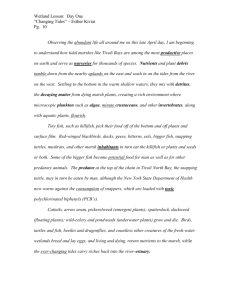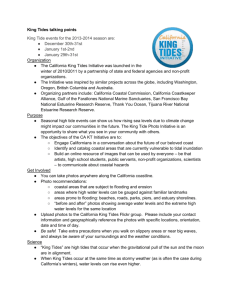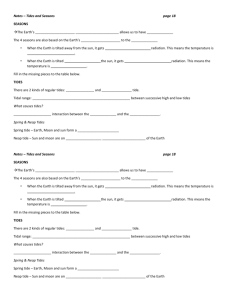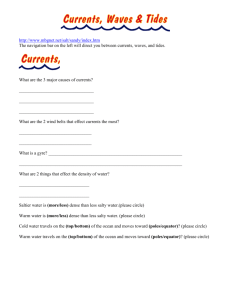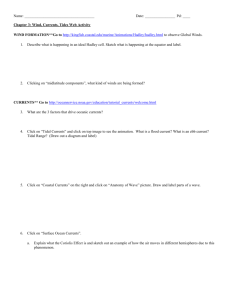Recent red tides in 2006 and 2007
advertisement
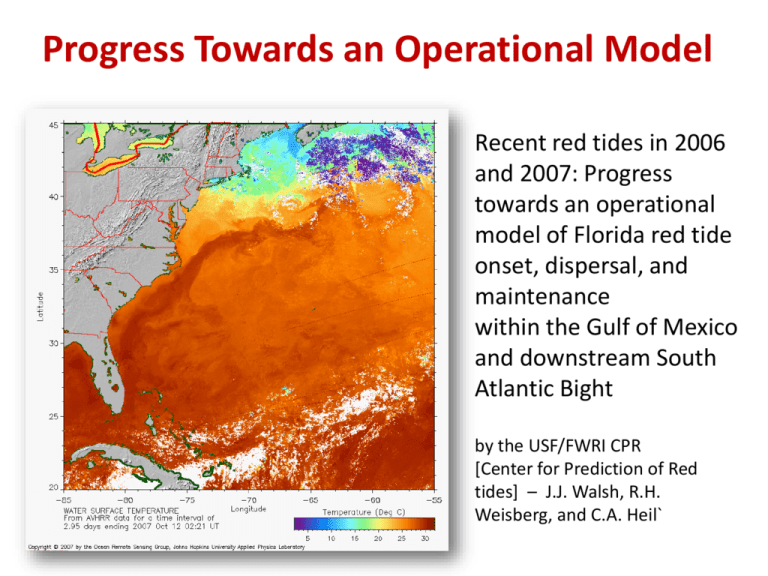
Progress Towards an Operational Model Recent red tides in 2006 and 2007: Progress towards an operational model of Florida red tide onset, dispersal, and maintenance within the Gulf of Mexico and downstream South Atlantic Bight by the USF/FWRI CPR [Center for Prediction of Red tides] – J.J. Walsh, R.H. Weisberg, and C.A. Heil` Center for Prediction of Red Tides (CPR) Based upon a tripartite funding scenario [NOAA, FWRI, and USF], we have recently formed the Center for Prediction of Red tides (CPR) as a joint USF/FWRI effort. We would like to acknowledge the help of our co-authors of many red tide publications over the last 20 years, in advancing our understanding of HAB onset, maintenance, and dispersal - both as necessary ingredients of coupled CPR models and for its long-awaited gestation. Of these past collaborators, 55% were USF graduate students, completing MS/PhD degrees, with committee members drawn from the five groups: – USF College of Marine Science – Fish and Wildlife Research Institute, Florida Fish and Wildlife Conservation Commission – Mote Marine Laboratory – Rosenstiel School of Marine and Atmospheric Science, University of Miami – Atlantic Oceanographic Meteorological Laboratory Economic Impact of Red Tide $49 million estimated economic losses caused by harmful algal blooms to the United States each year More than 50% is derived from Florida red tides of the slow growing Karenia brevis, which poisons other phytoplankton, fish, manatees, and sea birds. (Anderson et al., 2000) Social Impact of Red Tide These harmful algal blooms are aptly now described by popular writers in fictional accounts as “When the local news came on, ... the lead story was about a red tide that had killed thousands of fish, the majority of which had inconsiderately washed up to rot on the public beach in Fort Myers. The tourists were apoplectic, while the Chamber of Commerce had been scrambled to Defcon Three crisis mode. A video clip showed acres of bloated fish carcasses on the sand, pallid beachcombers fleeing with towels pressed to their noses” (Haisen, 2006 – Nature Girl, pg 78). As a result of CPR documentation of physical dispersion of red tides in 2007, from the WFS to Alabama and North Carolina coastal waters, they are now a prime marine example of Garrett Hardin’s “Tragedy of the Commons”, where dilution is not the solution to pollution over even a regional length scale of 500-1000 km coastline, from Tampa Bay to Mobile and Delaware Bays. This simulation analysis represents just one, albeit outstanding, example of recent multidisciplinary success stories, involving bright graduate students, engaged in the arcane art form of chimerical numerical oceanography of Florida coastal waters of both the Gulf of Mexico and the downstream South Atlantic Bight, from Miami to Cape Hatteras. Predicting Red Tides CPR forecasts of Florida red tides involve a combination of: Atmospheric Sciences and Biological, Fisheries, Chemical, and Physical Oceanography. • A reality check is imposed by plankton debris at the sea bottom, i.e. the realm of Geological Oceanography First CPR Paradigm of Red Tide Onset Transport of Saharan Dust A time series of aerosol index values during July 22-29, 2006 from the OMI instrument on the Aura satellite showing the transport of Saharan dust from North Africa to the Gulf of Mexico (Carder et al., 2007) – courtesy of NASA Goddard Space Flight Center Transport of Saharan Dust OMI satellite imagery (6/22-27/07) of Saharan dust penetration into both the Caribbean Sea, past Barbados and Miami on 25 June 2007, and the western Gulf of Mexico on 26 June 2007 – courtesy of NASA Goddard Space Flight Center Upwelling Provides Seed Populations Upwelling Provides Seed Populations Previously, upwelling had also provided subsurface seed populations of Trichodesmium and Karenia to surface waters near the Florida coast during late July 2006. After upwelling began on A) 28 July with warm surface waters near the coast, note that shelf bathymetry focused the cold temperatures, detected by AVHRR thermal imagery on B) 29 July and C) 31 July off Charlotte Harbor and Fort Myers, FL, where our numerical models also yield cold plumes of upwelled outer shelf waters. Indeed, upwelling occurs throughout the spring-fall seasons on the WFS, as during May 1994 and 1998, in response to winds from the northeast, but diazotroph blooms, as well as subsequent red tides, must await summer Saharan supplies of iron to the deeper (>30 m) WFS, where Trichodesmium of Caribbean origin are introduced, and diatoms are nitrate-limited. Since the upwelling loci at the coast, between Charlotte Harbor and Fort Myers, are focused there by the shelf bathymetry, both cold subsurface water parcels and their resident plankton populations, including red tides, diazotroph precursors, copepod herbivores, and postsettlement larval fish, entrained within the near-bottom Ekman layer, are all first concentrated in these regions as a consequence of the three-dimensional circulation fields. SST images are courtesy of the Johns Hopkins University Applied Physics Laboratory Origin of Red Tides is Not Related to Eutrophication To deal with WFS export of red tides, we expanded the circulation model’s grid to encompass AVHRR sea surface temperatures in the Gulf of Mexico and downstream South Atlantic Bight during 9/1, 6/2007 and 9/26, 28/2007 [http://fermi.jhuapl.edu/avhrr]. Note once more the upwelling locus off Fort Myers, which is focused by the bathymetry to yield a coastal red tide epicenter off Fort Myers, within an otherwise uniform nutrient habitat. Origin here of red tides thus has little relation to inferred eutrophication of the Caloosahatcheee River. Same Initial Conditions of Nitrogen Fixers during 2006 and 2007 T. erythraeum had similar distributions over the WFS during July 2006 and 2007, but by 3-4 October 2007 their populations were also observed along the East Florida coast, off both Titusville (28.4oN, 80.6oW) and Amelia Island (30.6oN, 81.4oW). In terms of abundance, similar amounts of diazotrophs were also found on the WFS during July 2006 and 2007. Second CPR paradigm of self-shaded, fish-fed maintenance of red tides Dead fish had now accumulated by mid-September 2006 on local beaches, i.e. those that escaped harvests by K. brevis in nearshore waters of the WFS. As much as 50% of some Florida fish decompose to inorganic phosphorus and ammonium within one day (Stevenson and Childers, 2004). Thus, putting them back in the water, let alone grinding them up, will lead to larger red tides, not smaller ones on the WFS!!! The dead fish did not go away, nor did the red tide in 2006, unlike during 2007. Instead, decomposing fish led to a red tide accumulation of >10 ug chl/l during September 2006, as they rotted in place. Then, 55 fish kills were associated with these red tides during September 2006 in coastal waters, between Tampa and Naples, compared to only 6 reported over this coastal region during September 2007. Along a similar length of coastline on the East Florida coast, between Melbourne and Fernandina Beach, the mirror image prevailed. During September 2006, only 7 fish kills were reported off the East Florida coast, all associated with low oxygen concentrations, not directly attributed to harmful algal blooms. In contrast, 43 fish kills were reported to FWRI in September 2007 during the greater physical export events, between Brevard and Nassau Counties, of which 39 of them were now caused by red tides of K. brevis seen by satellite. Simulated surface drifter trajectories released just along the West Florida coast: 8/6/2007 9/21/2006 9/6/2007 10/6/2006 Red tide went to the east coast in 2007; it stayed on the west coast in 2006 A time series of the alongshore mean weekly abundance (cells l-1) of K. brevis found at the surface during 1972 to 2007, within 9 km of the coast, between Tampa and Naples. It provides a 25-year record of interannual variation of intensity and duration of red tides within these coastal waters, with known eastward summer decantations during 1972, 1977, 1987, 1990, and 2007, thence leaving behind only small autumn amounts of these toxic dinoflagellates at the bottom of the WFS food web. NOTE SIZE AND DURATION OF 2006 and 2007 events. a) b) c) The 2006 case of the CPR model has a respective fish-fed red tide growth rate of 0.25 day-1, as determined from model fits of observed ichthyotoxic levels of K. brevis on 8/28/06 and 9/1/06, similar to those of diazotroph-fed maximal growth rates from other field data during June-August 1980. The satellite means of the first panel are from the areal white masks of >1 ug chl/l on those dates, as well as on 9/20/06, when dispersion over a wider area led to a smaller mean stock and growth rate of 0.08 day-1 over a longer time interval of 8/20-9/20/06. Recall coastal drifter trajectories on 9/21/06. 25 0.08 0.25 1.0 20 -1 Chl (ug l ) Satellite Mean 15 10 5 0 8/20/2006 8/22/2006 8/24/2006 8/26/2006 8/28/2006 8/30/2006 9/1/2006 9/19/2006 9/20/2006 9/21/2006 The 2007 case of the CPR model has a respective fish-starved red tide growth rate of 0.08 day-1, as determined from model fits of observed ichthyotoxic levels of K. brevis on 9/6/07, 9/8/07, and 9/13/07, unlike those larger rates derived from prior WFS field data during June-August 1980 and July-August 2006. Once more, the satellite means of the first panel are from the areal white masks of >1 ug chl/l on those dates, as well as on 9/29/07. Note that some fish kills were observed in 2007 on the WFS, but 10-fold less than in 2006, such that by mid-September 2007, maximal growth of 0.25 day-1 of K. brevis was no longer realized. Indeed, over a wider area in 9/02-29/07, it was 0.05 day-1. Recall coastal drifter trajectories on 9/6/07. 25 0.08 0.25 1.0 20 -1 Chl (ug l ) Satellite Mean 15 10 5 0 9/2/2007 09/06/07 9/4/2007 9/6/2007 9/8/2007 09/08/07 9/28/2007 9/29/2007 9/30/2007 9/10/2007 9/12/2007 9/14/2007 09/13/07 09/29/07 a) b) A second set of 70-day trajectories of surface drifters, representing water parcels of entrained WFS red tides of K. brevis, with start date of 6 September 2007 released along the A) 10-20 m and B) 60-80 m isobaths , as well as the 30-45 m isobaths of the Florida Middle Ground in the Big Bend region, off the West Florida coast, where color changes again depict days after release. Now, the CPR coupled model replicates red tide landfalls off both North Carolina and Alabama. a) A d) D b) B eE ) c) C e) f F ) Satellite imagery on 23 October 2007 of A) optical signatures of Trichodesmium (pale blue color) and Karenia (reddish- black color), B) total chlorophyll of the phytoplankton community, C) backscatter per unit chlorophyll, and D) fluorescence line height to minimize CDOM contamination of the color signal of phytoplankton, and E) sea surface temperatures, in relation to F) the computed surface red tides on that day, when the red symbols denote stocks of >34 ug chl l-1. The white crosses indicate launch sites of surface drifters and entrained initial red tides on 6 September 2007. Our joint goal of a future ecological model, HABSIM, coupled to various nested circulation models, for eventual forecasts of an operational model of both red tides and fisheries recruitment along coastal regions of the southeastern United States, from the West Florida shelf to the South Atlantic Bight, requires continued collaboration of state, federal, private, and university scientists with the next generation of bright graduate students, versed in quantitative tools honed by WFS studies, leading to realistic ecosystem-based management of marine biotic resources. Pressing questions of eutrophication at the bottom of the coastal food web and overfishing at the top must be addressed within the appropriate plankton context of physical transport of both harmful algal blooms and larval fish cohorts. Are the recent increases of cognitive failure in the adjacent states of Dementia (dyed carmine by frequent HABs), Fantasia, and Another Reality all the consequence of red tides in the Gulf of Rising Expectations, with downstream teleconnections to the We’ll Not Sea (not shown, of course)?? The same southward winds that export surface red tides out of the WFS to the Loop Current and contiguous Gulf Stream, trap other Texas red tides along the coastline of Dobbs state, thus leading to televised mania about their vertical immigration policies. A multi-century record of past Florida red tide dispersal and maintenance within the Gulf of Mexico and downstream South Atlantic Bight, since at least 1885-1886, ensures that future operational forecasts of their onset, duration, and landfall by the USF/FWRI CPR [Center for Prediction of Red tides] and its present collaborators, e.g. GSFC, JHUAPL, NCSU, RSMAS, AOML, and MOTE among others, will be of continued great societal value to coastal residents of the southeastern United States seaboard, from the Mississippi River delta to the Mid Atlantic Bight.
